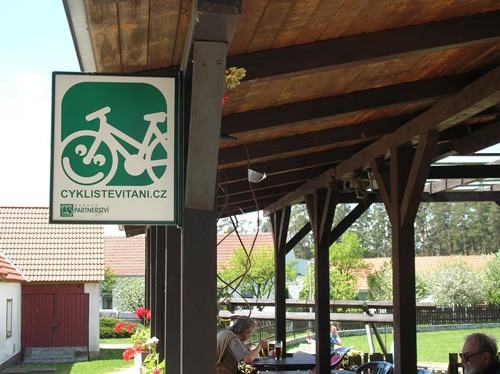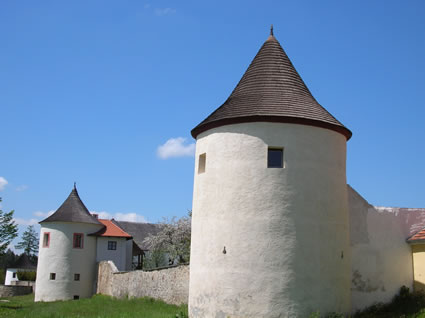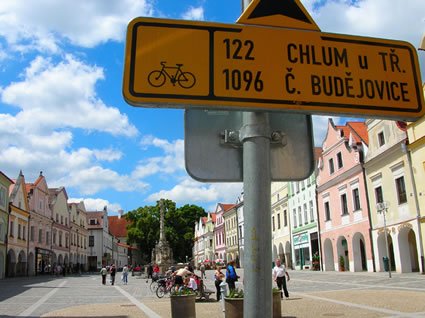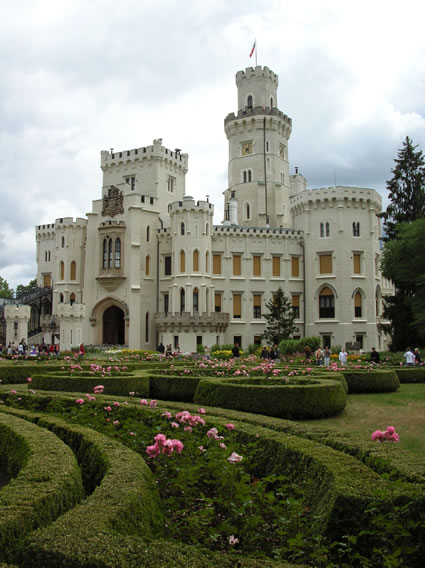Cycling in South Bohemia, Czech Republic
The author, who lives in the heart of South Bohemia, offers her tips on cycling in this idyllic part of Central Europe
Article and Photos by Pearl Harris

|
|
Cycling on the shady cycle path next to Lake Svet in Trebon, South Bohemia, Czech Republic.
|
Contrary to popular perception, it is not only the Dutch who are cycling fanatics. As soon as Spring approaches, Czechs of all ages come out en masse on their bicycles, ranging from pre-war models to the very latest in modern technology.
As expatriates from South Africa living in Buková, a tiny village in South Bohemia, the southern part of the Czech Republic which borders Austria and Germany, our home lies in the midst of some of the most ideal cycling terrain in Europe.
South Bohemia, with its well signposted cycle paths, beautiful forests and numerous lakes interspersed by small villages, annually attracts hordes of Czechs and international travelers in Spring and Summer for outdoor adventure holidays.
There can be few experiences more soothing to the soul than cycling through the dense Bohemian forests, with only the sound of birdsong audible in the distance. Mushrooms and wild berries grow in abundance in these lush forests and are there for the picking, as are apples, pears and cherries along the main roads. In the Communist era, these fruit trees were planted for the people to pick free of charge, as they still do today.
From a bicycle, you can absorb and enjoy the passing scene much more fully than from the window of a speeding car. You are likely to spot deer, hares, squirrels, wild ducks, swans, geese, pheasants, and other bird and animal life on the string of lakes or suddenly appearing from the forests. South Bohemia abounds in man-made lakes (rybníky), stocked with carp — a much-favored fish amongst the Czechs.
All cycle trails are well marked on special Cycle Maps. There is a veritable maze of routes to choose from along quiet main roads or shady forest paths. Distinctive yellow signboards indicate all the numbered cycle routes. Picturesque villages where time has stood still are dotted at short intervals along every route. Even the tiniest village sports at least one pub (hospoda) with free-flowing Czech beer (pivo), an essential commodity in slaking the thirst of cyclists, to whom a day well spent is one with frequent rest stops at village pubs by the wayside. Another advantage of a cycling holiday is that the strict drink-and-drive laws of the Czech Republic are apparently not applied to cyclists!
Czech motorists are exceptionally considerate of cyclists. The motto in the Czech Republic is: “Cyclists Rule!”. Cyclists, even in the dark, gaily bowl along without a care. Many of the ancient local bicycles are not even equipped with reflectors, let alone the luxury of lights. Motorists have developed a sixth sense for cyclists, giving them a wide berth on the road. It is a strict rule of the road for drivers to put on their flickers when overtaking a cyclist.
A great plus of cycling in South Bohemia is that you will experience total freedom and security, even when out in the dark by yourself on the road. Violent crime is virtually unknown in this area and this alone is balm for the soul of the visitor from more turbulent parts of the world.
Žumberk

|
|
Outside Zumberk's Penzion-restaurace Marie the welcome sign for cyclists is displayed.
|
A close and favorite cycling destination is the medieval walled village of Žumberk, a few miles north of Nové Hrady, close to the border with Austria. An easy, flat 1½-mile bike ride off the main road takes you within one of the only three preserved fortified villages in Europe. This Gothic settlement, mentioned in records as early as 1186, was rebuilt in the Renaissance style in the 17th century, with part of the fortifications and bastions existing to this day.
After a ride on roads lined with pink- and white-blossomed cherry and apple trees, amidst vast fields of golden rape and watched by grazing cattle in the meadows, we arrive at one of Žumberk’s two cozy guesthouses-cum-restaurants: Penzion-restaurace Marie and the Hospůdka na Hrádbach are oases where you may fortify yourself with hearty Czech food and cold beer. At Hospůdka na Hrádbach you can sit in the garden, overlooking the lake. Marie restaurant has a shady terrace where you may rest in the shade of the crumbling ochre façade of the 14th-century Church of St. John the Baptist, surrounded by the white walls and towers of the medieval fortress.
The Cyklo-Tourist sign displayed outside Marie restaurant welcomes cyclists. During the weekend, it can be difficult to find a parking spot for one’s bike on any of the bicycle racks outside the restaurant!
Should you wish to spend more time in this unique village in order to explore the surrounding countryside by bike, Penzion-restaurace Marie provides comfortable rooms above the restaurant. Or how about staying in one of the original bastions of Žumberk fortress? Adjacent to Hospůdka na Hrádbach and owned by the same family, this romantic refurbished tower accommodates six people in luxury, beautifully furnished, and with every modern convenience. Here, overlooking the lake and forest, you may relax in a private garden with a barbecue and enjoy the view.

|
|
The fortified village of Zumberk. One of these ancient towers is used as a guesthouse by Hospudka na Hrádbach.
|
Třeboň
Another favorite South Bohemian haunt for cyclists is Třeboň, situated approximately 20 miles east of České Budějovice, capital city of the region, and surrounded by natural forests and a network of artificial lakes. The ancient town nestles on the shores of Svet rybník (“World Fish Pond”), as this lake is known, and is part of the Třeboň Basin, a protected landscape of lakes, forests, peat bogs, fields and meadows, criss-crossed by streams and paths.
Třeboň and surroundings are not only of noteworthy environmental importance, being a UNESCO Biosphere Reserve, but also of enormous historical value. It is also one of the world’s best cycling regions to boot.
A day or weekend cycling excursion will offer plenty of time to explore this beautiful corner of the Czech Republic. Cycling through the impressive gateway in Třeboň’s old town, you instantly take a leap back in time. Třeboň Castle, an imposing 16th-century edifice built on the site of an original Gothic fortress, dominates the old town center.
Masarykovo Namesti, the old Town Square, is the nucleus of Třeboň. In this pedestrian zone with its rows of bicycle racks, cyclists take a breather at pavement cafés beneath the colorful facades of restored medieval buildings dating back 900 years. The surrounding streets and cobblestoned alleys are crammed with hotels, guesthouses, cycle, souvenir and craft stores, restaurants and pubs serving Czech specialties, such as home-bred kapr (carp), knedlíky (dumplings), smaženy sýr (fried cheese) and, naturally, the local brew, Regent’s beer. A corner cukrárna (ice-cream parlor) is popular for its delicious and unpronounceable Zmrzlina (ice-cream).
On the main square too, is the Tourist Office, providing free maps and information of the region.

|
|
Cycling signs in Trebon's main square.
|
Regent’s Brewery
While in Třeboň, join a tour of Regent’s Brewery, established in 1379, to learn more about this famed Bohemian beer, one of the country's oldest brands. The sunny Brewery Terrace is a pleasant spot to relax and savor Regent at its source. It was on this terrace that we once encountered an English couple who hailed from Chester and spent a pleasant couple of hours, swapping tales with this adventurous duo over a few beers. Past retirement age, grandparents Mark and Joan, having run a small business for their entire married life, simply packed their ancient bicycles on the back of their trailer and set off across the English Channel. In this nomadic fashion, they traveled across the whole of Europe, striking up camp wherever they wished and hopping on their bikes to explore the immediate neighborhood at leisure.
They were entranced by the beauty, tranquility and lack of crowds in South Bohemia and could not believe the incredibly low prices of food, lodgings and everything else. “The world’s best beer for 25p! Incredible!” beamed Mark over his foaming mug of Regent’s. “We must keep this place a secret!”, he smiled. “We don’t want the whole world to discover South Bohemia!” Local beer costs approximately $1per 500ml., varying from place to place and according to the brand. In a supermarket, you may buy a 500ml bottle of beer for as little as USD$25 cents.
Lodgings in Třeboň
An easy four-mile bike ride north along the main road from Třeboň to the village of Lužnice will lead you to homely, family-run Penzion Otepkovi, an ideal spot for an overnight stay. Charming hosts, Tomaš and Štepánka Otepka, give you a warm welcome to their modern Czech family home with its pine ceilings, floors and furnishings. The cheap overnight rate includes a hearty Czech breakfast, consisting of cold meats, cheeses, bread, croissants, sweet pastries, and tea or coffee.
Refreshed after bed and breakfast in comfortable Pension Otepkovi, you will be ready to undertake the 25-mile long educational cycling circuit around Svet lake which forms a loop starting and ending in Třeboň. There are 22 stops with maps and explanatory texts. For the less fit, the 8-mile trail around the shores of Svet lake is recommended. This trail has 16 stops and is an easy, flat path, manageable even by children and the elderly. By means of specially constructed wooden bridges for cyclists and hikers, the route traverses protected peat-bogs and forests.
Stopping for a breather at the information boards along the route, you will learn many little-known facts about the development of the region’s fish-breeding and spa industries, as well as about the local history, architecture, animal, and plant species.
Spas in Třeboň
After a strenuous day of cycling, you may need to join the many visitors who come to Třeboň to take the waters of its famous Spas, which utilize the local peat and mud in the rehabilitation and therapy of all types of muscular and arthritic disorders. Třeboň’s two Spas are frequented not only by patients seeking relief from ailments, but by perfectly healthy individuals, merely wishing to pamper themselves in its warm waters and to enjoy soothing massages in a stress-free environment. (A remarkable fact about the Czech Republic’s health care system is that a doctor may prescribe a 6-week stay in a Spa for a patient, which includes board and lodging, plus specialized physical therapy treatment, all at a minimal cost.)
Besides the vast network of fairly flat cycling and hiking trails and the healing waters of its Spas, Třeboň offers the visitor indoor and outdoor swimming pools and sauna facilities, bowling, squash tennis, mini-golf, health trails, and hiking trails.
Other Cycling Locations
A number of other South Bohemian towns also make ideal bases for cyclists, such as Česky Krumlov and Telč (both UNESCO world heritage sites), Jindřichův Hradec, Tabor, Nové Hrady, Trhové Sviny, and České Budějovice.
These towns are all linked by rail and bus services to Prague and are surrounded by networks of well maintained cycle paths. Castles are scattered throughout South Bohemia, with the most notable in Hluboká, Česky Krumlov, Orlik, Nové Hrady, Jindřichuv Hradec, Červená Lhota, and Třeboň.
For an active, invigorating, educational, low-cost, and enjoyable holiday-with-a-difference for people of all ages, cycling in South Bohemia simply cannot be beaten.

|
|
Hluboka, just one of South Bohemia's many castles.
|
|
For More Info
Getting There:
Most international airlines have flights arriving at Prague’s Ruzynĕ International Airport.
From Prague, take a bus or train southwards to České Budějovice or Třeboň, a journey of approximately 3 hours. Another option is to hire a car at Prague Airport. Bicycle racks may be hired with a car. Driving in the Czech Republic is pleasant, with short distances between towns and not much traffic once leaving Prague.
City Cycling:
Cycling in Prague is not to be recommended due to the density of traffic and lack of cycle paths. Bicycles are allowed on the underground and trains if you buy a special ticket. The use of a bicycle lock at all times is recommended, especially in cities. Although serious crime is rare in the Czech Republic, bicycle theft is quite common.
Cycle Hire:
Cycle sale, hire, and service shops are plentiful in most towns.
One of the best cycle hire bets, at the low cost of approximately $4-$12 per day, is from České Dráhy (Czech Rail), who have introduced a special service for cyclists. Travel by train to the destination of your choice and hire your bike right there at the station. Booking may be done in advance through the internet. You can have the bike deposited at all stations on selected lines free of charge. You do not have to return the bike to the station where you hired it, but it can be returned at any of the listed stations. A returnable deposit is required (approximately $60). This service is available annually from 1st April to 31st October.
In South Bohemia, the following stations offer this exceptional bike rental service: Tábor, Veseli nad Lužnice, Jindřichův Hradec, Třeboň and České Velenice (on the Austrian border.)
Cycling Aids:
A comprehensive range of detailed cycle maps of each area, as well as essential Czech-English Phrase Books and Dictionaries are available from all bookstores, many supermarkets, and gas stations.
The latest in cycling aids now available — in the form of a satellite navigation gadget offering the most minute detail of every cycle path in the country — could prove very useful when attempting to interpret some of the baffling Czech names on road signs and maps.
Climate:
The best time to visit the Czech Republic is from the beginning of May to the end of August, when the days are long and sunny — ideal for cycling. In mid-Summer, daylight hours extend from 5 a.m. to 10 p.m. and maximum temperatures average a pleasant 70°F.
Language:
The main language spoken is Czech, but German is also spoken by many of the older generation, while English is becomingly increasingly common among younger people.
Money Matters:
The use of credit cards in smaller towns and villages is not widespread, but with a Eurocard, one is able to withdraw cash from ATM’s throughout the country. Exchange offices are numerous and banks are open Mondays–Fridays.
Tourist Information:
Note: The Czech Republic officially changed its name to Czechia April, 2016, but the new name is still seldom used by English speakers, though preferred by the government.
Offices always have multilingual staff on duty. Conducted tours of the castle interiors are conducted in English, in addition to Czech and other major European languages.
Prague Information Service:
The official website of Czechia has much useful information for cyclists.
CZeCOT, the Tourist Server of the Czech Republic has useful information on cycling, as well as some rather baffling information about cycle signs: “The cycling paths are marked by yellow signs bearing the number of the route. Forest paths for cyclists and many local routes are marked by colored “band” signs. You will also come across other signs where the route is not marked in the way prescribed by the Czech Hiking Club or where the signs mark a route stretching into this country from abroad. Apart from the marked routes, there are also recommended routes that require a map to follow. These often involve a circular route in places of local interest and usually link up to marked long-distance, regional and local routes. One example of this is provided by the South Bohemian Beer Trails.”
Be prepared to get lost! However, you will find the Czech people most helpful to foreigners. All you need to do is point at your map and you will be given copious directions. You will always find someone willing and able to speak English.
For beer lovers, the South Bohemian Beer Trails may be undertaken with special maps for this purpose.
Cycling Tours: Either self-guided or guided tours of various lengths are offered by many Czech bike tour companies.
|
Pearl
Harris was born in South Africa where she spent
most of her life before emigrating to the Czech Republic
with her husband, Ian, in 2002. Besides travel, her
passions are writing, photography, reading, and animals.
She has a B.A. in English & Linguistics, post-graduate
Diploma in Translation and TEFL qualification. Formerly
an EFL teacher, Pearl now freelances and you can find more information on her website about her work proofreading, editing, and writing.
Pearl has been widely published in magazines
and on the web. Her travel memoirs, From
Africa to Buková, and the sequel Where
is my Home? are available on Amazon.com.
|
